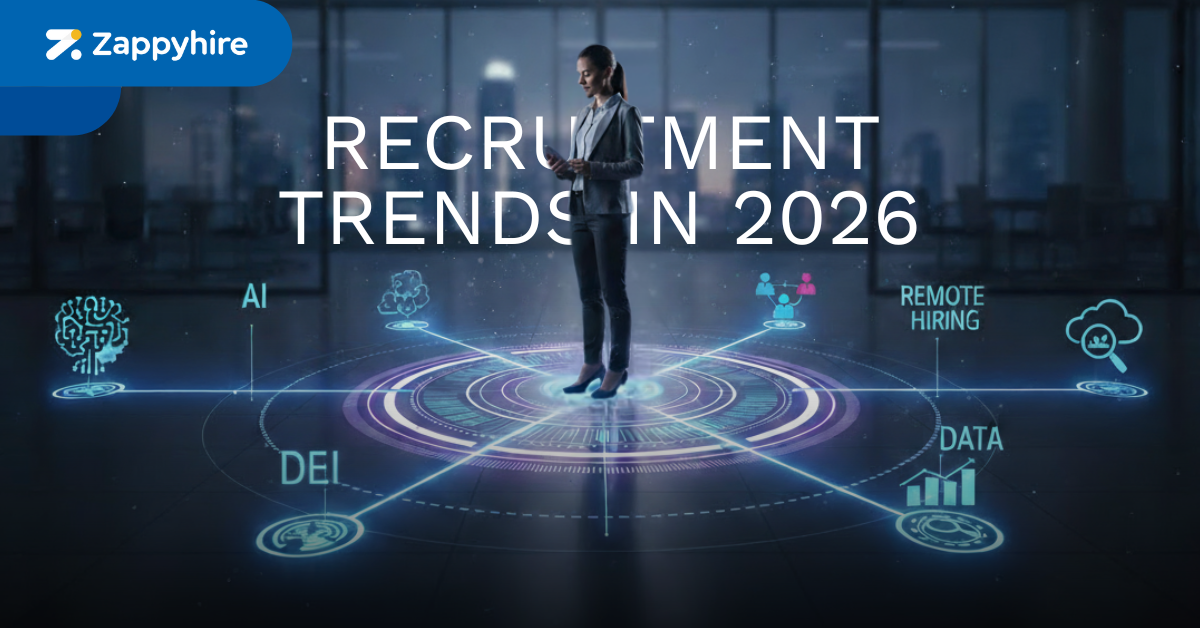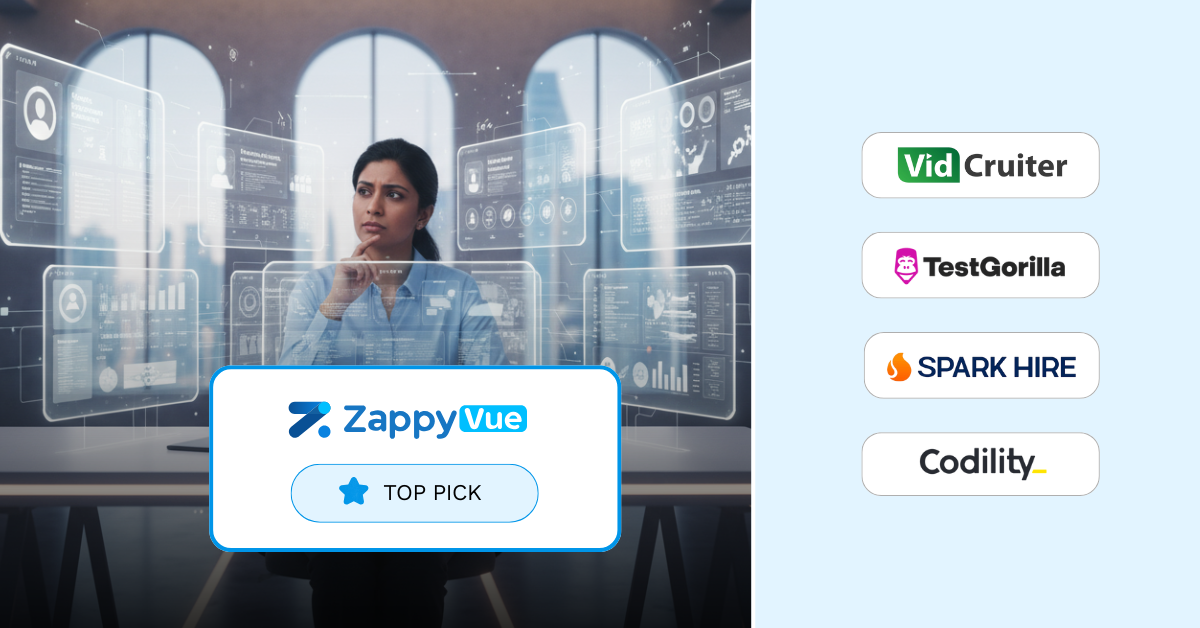
🗘 Last Updated on November 7, 2025
Recruitment leaders are heading into 2026 with a very different toolkit than just a couple of years ago.
Korn Ferry’s latest survey (2026) found that 84% of talent leaders plan to use AI in their recruitment efforts next year.
Artificial intelligence (AI) is moving from hype to standard practice making it a must have across organizations.
Amid economic uncertainty and evolving workplace expectations, HR professionals now play a pivotal role – not just in filling roles, but in orchestrating agility and innovation across their organizations.
In order to stay competitive, they must track the trends shaping tomorrow’s talent market and adopt strategies that speak to a changing workforce. The future of hiring, therefore, belongs to organizations that can blend intelligence with empathy and agility at every stage of the talent journey.
Below are ten evidence‑backed recruitment trends for 2026 and what they mean for your hiring strategy.
10 Recruitment Trends That Are Shaping Hiring in 2026
1. AI‑powered recruiting stays mainstream
LinkedIn’s Future of Recruiting found that 37% of companies are integrating or experimenting with generative AI for recruiting, saving recruiters hours and weeks of work and prompting 73% of talent acquisition professionals to believe AI will fundamentally change how hiring works.
The biggest shift in 2026 is that AI will be embedded into each stage of the hiring funnel. Recruiter co-pilots will help source and shortlist candidates faster by analyzing profiles and recommending best fits.
AI avatars and automated video interview platforms will handle first-round screenings, scoring responses for skills and role suitability.
Engagement assistants will personalize outreach, schedule interviews, and keep candidates informed. And interview intelligence systems will support hiring managers by summarizing discussions, highlighting strengths and risks, and helping teams make more consistent decisions.
Bottom line – AI adoption will continue in 2026, but human judgement remains critical. HR teams need to pair AI‑driven recruiting tools with transparent processes and clear accountability to avoid bias.
CHROs should invest in AI education programs so they understand how algorithms rank candidates and can explain decisions when asked.
2. Skills‑based hiring overtakes credentials
Skills‑first recruitment is shifting focus from degrees to competencies. The National Association of Colleges and Employers (NACE) reported that almost two‑thirds of employers use skills‑based hiring and less than 40% screen by GPA.
Organizations adopting this model often use it most or all of the time. LinkedIn’s Skills‑Based Hiring report shows why: a skills‑first approach can expand global talent pools 6.1× overall and 8.2× for AI roles, increasing female representation in AI jobs by up to 24%.
In the United States, the same methodology would expand the candidate pool 15.9×. In addition, job postings demanding specific years of experience have dropped from 40% in October 2022 to 32.6% in October 2024.
Bottom line – So, how do recruiters implement skill-based hiring? For recruiters, a skills‑first mindset means rethinking job descriptions, adopting assessments that measure practical abilities and looking beyond traditional degree requirements.
This approach also supports DEI initiatives by opening doors to under‑represented groups and candidates without four‑year degrees.
3. Internal talent marketplaces take off
When budgets tighten, organizations are looking inward. DDI’s 2025 HR Insights Report found that 50 % of organizations are prioritizing internal talent development, yet only 20% of chief HR officers have leaders ready for critical roles.
Their research also showed that 75% of organizations now prioritize internal promotions for leadership roles. The advantages are clear – outside hires can cost up to 20 % more and need up to three years to match insiders’ productivity, while internal moves fill roles faster and preserve institutional knowledge.
CHROs that implement structured succession systems see 3.7× more successful promotions when leaders participate in cohort‑based programs and 3.2× more success with sequential development curricula.
Bottom line – Expect 2026 to bring a surge in talent marketplaces – internal platforms that match employees to projects, stretch assignments and mentorships. These systems help employees find opportunities without leaving the company, reduce turnover and surface hidden skills.
AI can personalize recommendations, while transparent scorecards track promotion velocity and slate diversity.
4. Upskilling and reskilling become business survival strategies
The World Economic Forum’s Future of Jobs 2025 report indicates that 50% of workers will need reskilling by 2025 and 85% of surveyed employers plan to focus on upskilling. Nearly six in ten workers will need training before 2027, yet only half currently have access to appropriate programs.
Leading organizations are responding by prioritizing skills-first talent strategies. For instance,
- HSBC unlocked nearly 60,000 hours in productivity and redeployed 25% of restructured employees into new roles through a skills-based internal mobility platform.
- The Hartford redesigned roles within its workers’ compensation division and improved efficiency through targeted upskilling instead of layoffs.
- Mastercard AI-powered talent marketplace, Unlocked, has enabled 1 million internal project hours, with 93% adoption and 42% monthly engagement; and one in three engaged employees has made a career move.
Bottom line – For recruiting, this means looking for learning agility alongside technical skills. Employers should offer micro‑learning, mentorship and tuition support to help employees grow into future roles.
Candidates will increasingly value employers that provide clear pathways to develop new capabilities, especially in AI, data analytics and sustainability.
5. Data‑driven hiring and predictive analytics
Forward‑thinking recruiters are embracing data to predict turnover, optimize sourcing, improve fairness and even deduce who the right hires will be using predictive hiring.
Studies suggest that organizations using predictive analytics reduced turnover by around 30%. Predictive models can now forecast how policies affect well-being and attrition, while recruitment analytics can pinpoint bottlenecks in the interview funnel.
Bottom line – So, in 2026, expect wider deployment of dashboards that pull data from applicant tracking systems, assessments and employee engagement surveys. Organizations will need clear governance to ensure these analytics respect privacy and avoid algorithmic bias.
6. Hybrid and flexible work remain a strategic must
Remote work is here to stay – but not in its pandemic form. Research by Robert Half shows that 88% of employers offer some hybrid work options, though only 25% provide hybrid arrangements to all employees.
In Q2 2025, 24% of job postings were hybrid and 12% were fully remote. Candidate preferences align: only 19% of job seekers want fully in‑office roles, while 50% prefer hybrid and 25% prefer fully remote; 70% include hybrid among their top choices. Hybrid listings have climbed from 15% in Q2 2023 to 24% in Q2 2025 and fully in‑office postings have dropped from 83% to 66%.
Meanwhile, Indeed data shows that 23.8% of employees teleworked in October 2024 and 57.8% of job postings listed pay information, up from 52.2% the year before. The share of postings advertising benefits has risen too, but growth has slowed.
Bottom line – For employers, offering flexible schedules and transparent compensation is no longer optional. Hybrid arrangements widen the talent pool and improve retention as 76% of workers say flexibility affects their desire to stay with an employer.
Recruiters should highlight flexibility and pay transparency early in the hiring process to stand out.
7. Elevating the candidate and employee experience
In a market where employees have choices, candidate experience matters. CareerPlug’s 2025 Candidate Experience Report found that 66% of candidates said a positive hiring experience influenced their decision to accept a job.
Conversely, 26% declined offers due to poor experiences, and 36% declined offers due to negative interview interactions. The same report shows that 47% of job seekers expect to see salary details before applying.
Bottom line – Recruiters can differentiate by communicating clearly, enabling them to take interviews at their convenience with AI-powered video interviews, and personalizing interactions.
Involving hiring managers early, setting realistic timelines and providing feedback – even when a candidate is not selected – builds goodwill and strengthens the employer brand.
8. Diversity, equity and inclusion under scrutiny
DEI is not going away despite political headwinds. Diversity. com’s 2025 DEI Workplace report show that 59% of employees say discrimination is still happening in their workplace, and 57% have personally experienced it.
Women, professionals of color, and both the youngest and oldest employees are among the most affected. Yet despite the continued emphasis on inclusion, 1 in 4 employees still does not feel safe speaking up at work.
Organizations are talking about diversity, but many employees are not experiencing psychological safety or fairness in daily work interactions. This disconnect between policy and lived experience signals that DEI efforts can no longer be measured by the presence of programs – they must be measured by outcomes.
Bottom line – In 2026, expect a shift toward evidence-based DEI, including building more inclusive talent pipelines, auditing AI systems for bias, and strengthening psychological safety. Transparent metrics and leadership accountability will become the strongest indicators of real commitment.
Age diversity also deserves attention: the U.S. Bureau of Labor Statistics projects that the number of workers over 75 years old will rise from 1.8 million in 2018 to 3.7 million in 2028, representing 105% growth, while 65‑ to 74‑year‑old workers are expected to grow by 51%.
9. Sustainability and the rise of green jobs
Sustainability is reshaping the labor market. Green sector roles – from renewable‑energy engineers and carbon accountants to sustainability consultants – are booming.
According to Forrester, green jobs will increase by 17.9 million between 2024 and 2030 – growing from 66 million to 84 million workers across 14 countries. This reflects a 4.1% CAGR, far outpacing overall workforce growth of just 0.8% over the same period.
Moreover, roughly one‑third of American workers whose jobs are threatened by automation or AI – up to 51.6 million people – could be reskilled into green roles. This expansion reflects increasing investment in renewable energy, circular economies and environmental compliance.
Bottom line – For recruiters, sustainability skills – such as carbon accounting, ESG reporting, and climate‑risk analysis – will become as important as digital literacy.
Highlighting an employer’s environmental commitments can attract environmentally conscious candidates, particularly younger workers who prioritise purpose.
10. Pay transparency and total rewards
Compensation conversations are becoming more open. Indeed’s 2025 Hiring Trends report shows that 57.8% of job postings included pay information in September 2024, up from 52.2% a year earlier.
Listing salary ranges accelerates hiring by setting clear expectations and promotes fairness. Meanwhile, benefits and flexible perks remain important; 61% of job postings mentioned benefits in October 2024, compared with less than 40% during the pandemic.
Bottom line – Recruiter teams should work with compensation teams to develop transparent salary bands and communicate them early. Offering flexible benefits – such as mental health support, parental leave and learning stipends – can differentiate offers in a fast-moving market.
Final Takeaways
As we move into 2026, successful recruitment strategies will be those that embrace technology without losing humanity, focus on skills over credentials, and offer flexibility and transparency.
Investing in internal talent, cultivating continuous learning, and and prioritizing inclusive, data‑driven practices will help organizations attract and retain high‑quality candidates in an uncertain labor market.
By keeping these recruitment trends on your radar and aligning them with your company’s values, you can build a future‑ready hiring strategy that stands the test of the rapid workplace evolution that’s been happening this past decade.





